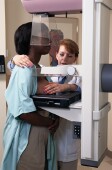
FRIDAY, April 29 (HealthDay News) — A pair of studies released Friday could shake up the debate on whether or not American women should begin regular mammography screening in their 40s.
One study, presented at the annual meeting of the American Society of Breast Surgeons in Washington, D.C., found that screening women aged 40 to 49 with mammograms detected smaller breast cancers, with less chance of spread to the lymph nodes, than relying on clinical breast exams alone.
That finding runs counter to controversial recommendations issued late in 2009 by the U.S. Preventive Services Task Force (USPSTF), which advised that women at average risk for breast cancer do not have to begin regular mammography screening until age 50. Instead, the federal panel of experts advised that the decision for or against mammography for women in their 40s be individualized after a patient-doctor discussion.
A second study presented at the same meeting on Friday suggests that the USPSTF guidelines would unfavorably impact minority women in their 40s.
Dr. Paul Dale, chief of surgical oncology at the University of Missouri-Columbia and lead author of the study looking at early detection, said his view on the issue is clear: “I think women in their 40s should get mammography.”
In their study, Dale and his colleagues looked at the medical records of almost 1,600 women treated at the university medical center for breast cancer over a 10-year time period. The researchers focused on 311 women aged 40 to 49.
Of these, 47 percent were diagnosed via mammography, while 53 percent were diagnosed without mammography (for example, by symptoms of breast cancer).
Those diagnosed by mammogram had smaller tumors — an average of 2 centimeters in diameter versus 3 centimeters, the team found. They also had less chance of the tumor having already moved into the lymph nodes, where it becomes more difficult to treat. While about 25 percent of those who had mammograms had lymph node involvement, almost 56 percent of those who did not have mammography showed this type of cancer spread.
When the researchers focused on the five-year disease-free survival of women in their 40s, Dale found 94 percent of the mammogram-detected group had disease-free survival compared to 71 percent in the non-mammogram group. The rate of overall survival (disease-free or not) at five years was 97 percent for those in the mammogram group versus 78 percent for women in the other group.
According to Dale, the findings suggest that women in their 40s who develop breast cancer “are going to do better if they have a mammogram.”
In the second study, researchers analyzed a large database of nearly 47,000 American women with breast cancer. Of that, 22.6 percent were aged 40 to 49, while 77.4 percent were 50 to 74.
About 66 percent of the patients were white, about 15 percent were Hispanic, about 13 percent were Asian or Pacific Islanders and about 6 percent were black.
“We looked at a population of women who only had early breast cancer, and compared the younger, 40 to 49 — not recommended [routinely] to have screening — with an older population,” explained Dr. Sharon Lum, associate professor of surgery at the Loma Linda University School of Medicine in Loma Linda, Calif.
“What we found was in the younger, 40 to 49, group there was a greater proportion of minority women [with early cancers] than in the older group [of the same ethnicities],” she said.
Therefore, according to Lum, “if you exclude younger women from screening mammography, it could disproportionately affect minority women.”
Dr. Otis Brawley, the chief medical and scientific officer for the American Cancer Society, reviewed both studies but was not involved in either.
“I do believe we should start [screening mammograms] at 40,” said Brawley, who is also professor of oncology and epidemiology at Emory University School of Medicine in Atlanta. The American Cancer Society continues to recommend that all women begin screening mammograms at age 40, he said.
Even so, Brawley said he has some issues with the new mammography research. For instance, the five-year survival time studied in the Dale study is just not long enough, he suggested. A better approach is to study what experts call a “mortality endpoint,” to find the number of people per every 1,000 who died in the screening group versus the non-screened group.
“That typically takes more than five years,” he explained.
Furthermore, all research presented at medical meetings should be viewed with a grain of salt, Brawley said. It’s in the first stages of research, and has not yet been subjected to rigorous debate and review by other medical experts.
In that respect, these should be considered tentative findings, he said.
For her part, Dr. Virginia Moyer, current chair of the USPSTF, said the public often misreads the panel’s controversial 2009 guidelines, thinking no one 40 to 49 should have a mammogram.
“This is not what the recommendation says,” she stated. “It says that the decision should be individualized, taking patient context into account, including the patient’s values regarding benefits and harms.”
As to the new studies, “the first study confirms what we already know, and the second study points out that our knowledge in specific groups of women remains incomplete,” said Moyer, professor of pediatrics and head of academic general pediatrics at Baylor College of Medicine and the Texas Children’s Hospital, in Houston.
Moyer said it is known that, on average, mammogram screening results in some benefit. But, “for women in the 40- to 49-year-old age group, this benefit appears to be quite small, and has to be balanced against the known risks, which are greater in younger than in older women,” she said. Among those potential risks are false-positive results, and the undue anxiety and unnecessary biopsies that can result, Moyer noted.
More information
For more details on the 2009 guidelines, head to the USPSTF.

